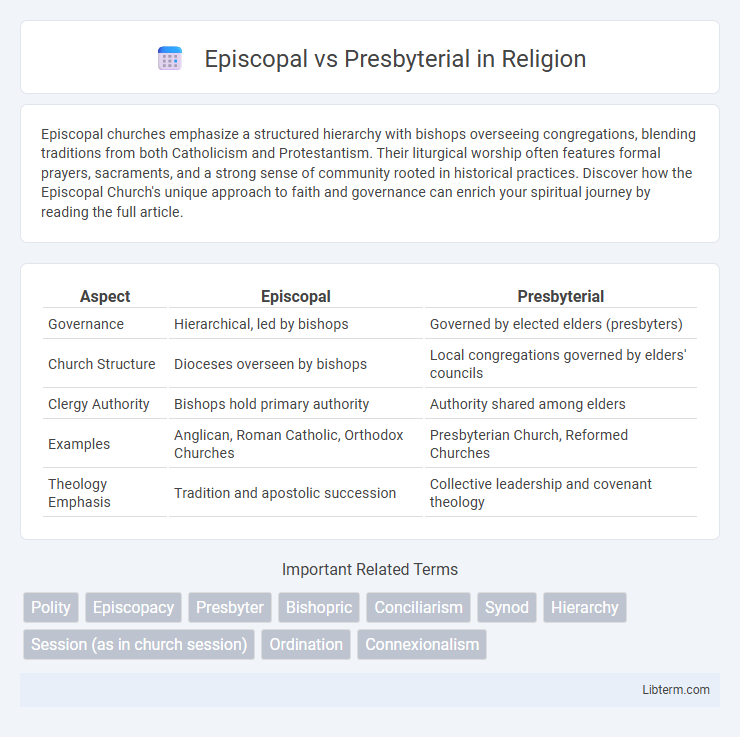Episcopal churches emphasize a structured hierarchy with bishops overseeing congregations, blending traditions from both Catholicism and Protestantism. Their liturgical worship often features formal prayers, sacraments, and a strong sense of community rooted in historical practices. Discover how the Episcopal Church's unique approach to faith and governance can enrich your spiritual journey by reading the full article.
Table of Comparison
| Aspect | Episcopal | Presbyterial |
|---|---|---|
| Governance | Hierarchical, led by bishops | Governed by elected elders (presbyters) |
| Church Structure | Dioceses overseen by bishops | Local congregations governed by elders' councils |
| Clergy Authority | Bishops hold primary authority | Authority shared among elders |
| Examples | Anglican, Roman Catholic, Orthodox Churches | Presbyterian Church, Reformed Churches |
| Theology Emphasis | Tradition and apostolic succession | Collective leadership and covenant theology |
Understanding Church Governance Systems
Episcopal church governance is characterized by a hierarchical structure with bishops holding authority over clergy and congregations, ensuring centralized leadership and doctrinal uniformity. Presbyterial governance, typical in Reformed traditions, relies on a system of elected elders or presbyters who collectively govern local churches through representative assemblies, emphasizing shared leadership and accountability. Understanding these distinctions clarifies how authority, decision-making, and church polity function within diverse Christian denominations.
Defining Episcopal Polity
Episcopal polity is defined by a hierarchical structure where authority is vested in bishops who oversee multiple congregations and clergy within a diocese. This system emphasizes the apostolic succession of bishops, ensuring doctrinal unity and centralized governance through ordained episcopacy. Key denominations practicing episcopal governance include the Roman Catholic Church, Anglican Communion, and Eastern Orthodox Church.
What Is Presbyterial Polity?
Presbyterial polity refers to a church governance structure where authority is vested in elected elders or presbyters who govern congregations collectively through representative assemblies. This system emphasizes shared leadership and accountability across multiple levels, such as sessions, presbyteries, synods, and general assemblies, ensuring decisions reflect a broader community consensus. Unlike episcopal polity, which centers power in bishops, presbyterial polity promotes a more decentralized, representative leadership model in organizations like the Presbyterian Church.
Historical Origins and Development
Episcopal governance, rooted in early Christian traditions, developed through a hierarchical structure with bishops overseeing clergy and congregations, tracing back to the early church councils in the 4th century. Presbyterian polity emerged during the Protestant Reformation in the 16th century, emphasizing a representative system governed by elders or presbyters, heavily influenced by John Calvin and the Reformed churches. The historical evolution of Episcopal government reflects continuity with apostolic succession, while Presbyterian structure represents a shift towards collective leadership and decentralized authority.
Leadership Structure: Bishops vs Elders
Episcopal leadership structure is characterized by hierarchical governance where bishops hold authoritative roles overseeing dioceses and clergy. In contrast, Presbyterian governance centers on a representative system led by elders elected from the congregation, emphasizing shared leadership and accountability. The episcopal model grants bishops significant ecclesiastical authority, while the presbyterian model distributes leadership responsibilities among a council of elders.
Decision-Making and Authority
Episcopal governance centralizes decision-making authority in bishops who oversee clergy and congregations, ensuring hierarchical control and doctrinal unity across the church. Presbyterian governance distributes authority among elected elders and regional assemblies, promoting collective decision-making and shared leadership within the congregation. This structural difference impacts how policies are implemented, with Episcopal systems favoring top-down directives and Presbyterian systems encouraging representative input and consensus.
Role of Congregations in Governance
In Episcopal governance, congregations have limited authority as decision-making power is centralized in the hierarchy of bishops, who oversee and guide church policies. Presbyterian governance empowers congregations through a representative system of elders who participate in local sessions, regional presbyteries, and national assemblies, sharing authority and decision-making responsibilities. This model fosters collective accountability and active lay involvement in church governance, contrasting sharply with the top-down structure of Episcopal oversight.
Denominations That Use Each System
Episcopal church governance is predominantly used by denominations such as the Roman Catholic Church, the Anglican Communion, and the Eastern Orthodox Church, characterized by a hierarchical structure with bishops holding authority over clergy and laity. Presbyterian governance is primarily found in Reformed Protestant denominations like the Presbyterian Church (USA), the United Church of Christ, and the Reformed Church in America, emphasizing a system of representative assemblies with elected elders overseeing church affairs. These differing governance models reflect theological and historical distinctions influencing worship, doctrine, and organizational decision-making within Christian traditions.
Advantages and Challenges of Each Polity
Episcopal polity offers centralized leadership through bishops, which ensures doctrinal uniformity and cohesive governance but can risk hierarchical rigidity and slower adaptation to local needs. Presbyterial polity empowers elders and congregations with shared governance, promoting greater local input and accountability, though it may face challenges in maintaining unity and consistent doctrine across diverse congregations. Both systems balance authority and community involvement differently, affecting organizational flexibility and theological coherence.
Contemporary Relevance and Trends
Episcopal governance emphasizes a hierarchical structure led by bishops, which remains prominent in Anglican, Roman Catholic, and Orthodox churches, ensuring centralized authority and doctrinal consistency. Presbyterial (or Presbyterian) governance features representative assemblies of elders, promoting collective decision-making and adaptability in many Reformed and Presbyterian denominations. Contemporary trends show increased dialogue and cooperation between these systems, reflecting a shared focus on accountability, lay participation, and evolving approaches to church leadership in modern contexts.
Episcopal Infographic

 libterm.com
libterm.com